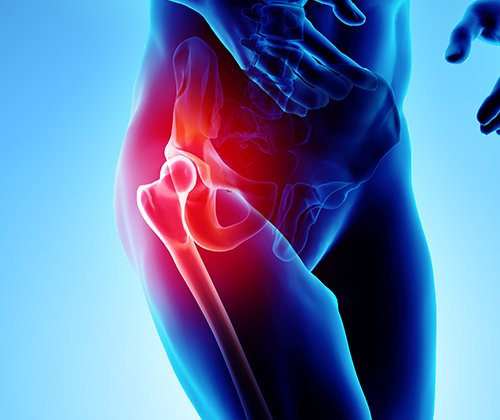How to treat hip pain - arthritis
For football players, marathon runners, gymnasts, and other competitive athletes, dealing with orthopaedic and sports injuries is commonplace. However, a painful joint injury does not have to occur on the field or court. Everyday joint injuries occur all the time, whether it's from lifting a large load of groceries or going for a jog around the neighbourhood. If not handled properly, they, too, can lead to long-term issues.
Joint diseases, particularly hip disorders that can result in chronic hip discomfort, are among the most common causes for going to the doctors and physiotherapists.
Know your body's boundaries if you have hip pain.
It's critical to pay attention to your body's signals to slow down. We sometimes try to push through the discomfort, but if you're not careful, you could wind up causing more harm. You can't always walk away from hip discomfort or treat it by taking anti-inflammatory medications.
Our ability to recover slows as we get older, and our hip tendons lose their suppleness. It's similar to how a rubber band loses elasticity over time. The greatest thing we can do is start doing low-impact workouts like biking or swimming, which are less stressful on the hips.
It's also crucial to remember to allow your body to heal between workouts, as this might help you avoid injuries.
When should you consult a clinician regarding hip pain?
Whether you're competing in sports or just going for a walk around the block, joint injuries are unavoidable. Rest, ice, compression, and elevation are frequently used to treat minor hip joint ailments at home. However, there are situations when seeing a doctor or physiotherapist is necessary to prevent further injury to your hip and promote correct healing.
If you have any of the following symptoms after damaging your hip, you should seek medical attention:
Instability or buckling of the hip
Inability to bear weight on your hip
Limited range of motion
Persistent hip pain
Significant tenderness
Weakness or lack of strength while moving your hips and legs
How we Treat Hip Pain?
According to British Journal of Sports Medicine Intra-articular injections represent a commonly used modality in the treatment of hip osteoarthritis (Gazendam et al 2020). Doctors or physiotherapists may inject medication directly into the hip joint under the Ultrasound guidance if medication and physiotherapy do not improve discomfort caused by hip impingement syndrome. Injections don't treat the underlying structural problem, but they can help reduce inflammation and restore the smooth, gliding motion of the joint's ball and socket components.
Corticosteroid Injection: Under Ultrasound Guidance
Corticosteroids are anti-inflammatory drugs that can be injected directly into the hip joint to relieve pain. Inflammation is a portion of the body's immune system reaction that causes pain and swelling. Corticosteroids diminish inflammation.
To offer short-term yet instant pain relief, doctors typically inject a little quantity of anaesthesia together with corticosteroids. After the anaesthesia wears off a few hours after the injection, hip discomfort may reappear. Two to three days later, the corticosteroid solution starts to function.
A corticosteroid injection may give pain relief that lasts for months for some people, but it may not be beneficial for others. The majority of people get pain alleviation that lasts a few weeks or months.
A total of two or three corticosteroid injections in the hip joint is recommended by doctors.
Hyaluronic Injection (Ostenil Plus): Under Ultrasound Guidance
Solution containing hyaluronic developed specifically for the treatment of osteoarthritis. They can be injected into the hip, or any of the other synovial joints in the body to decrease pain and stiffness and improve the other symptoms of osteoarthritis.
They can be injected into the joint to support both gliding and the regeneration process therefore decreasing pain and improving other symptoms.
They contain higher concentration of hyaluronic (visco-supplementation) and offers the option to reduce the number of injections to one per treatment cycle.
What to Expect After Injections
In the days following therapy, clinicians recommend applying an ice pack for 15 minutes at a time three times a day if the injection site is uncomfortable or swollen.
For the first four weeks after the injection, you should avoid doing any strenuous tasks with your hip. This allows time for the wounded tissue to heal.
Ultrasound Guided Injection for Hip Osteoarthritis and Impingement
Surgery
Hip OA are highly prevalent and disabling. Education, exercise and weight loss are cornerstones of management, complemented by pain management medicines, corticosteroid injections, and several adjunctive medications such as Ostenil Plus. For persons with advanced symptoms and structural damage, total joint replacement effectively relieves pain and improves mobility (Jeffrey et al 2021).
To book for an appointment you can call our normal reception line, 0121 285 5656 or email direct to hello@thepodiatryclinics.co.uk requesting an appointment. Please include your name, date of birth, your address and GP contact details.
You will be sent a form to complete and forward back to us or bring along on the day. OR simply click the button below!
References:
JAMA. 2021 Feb 9;325(6):568-578. Diagnosis and Treatment of Hip and Knee Osteoarthritis: A Review. Jeffrey N Katz 1 2 3, Kaetlyn R Arant 1, Richard F Loeser 4
Br J Sports Med. 2021 Mar;55(5):256-261. Intra-articular saline injection is as effective as corticosteroids, platelet-rich plasma and hyaluronic acid for hip osteoarthritis pain: a systematic review and network meta-analysis of randomised controlled trials. Aaron Gazendam 1, Seper Ekhtiari 2, Anthony Bozzo 2, Mark Phillips 3, Mohit Bhandari 2



